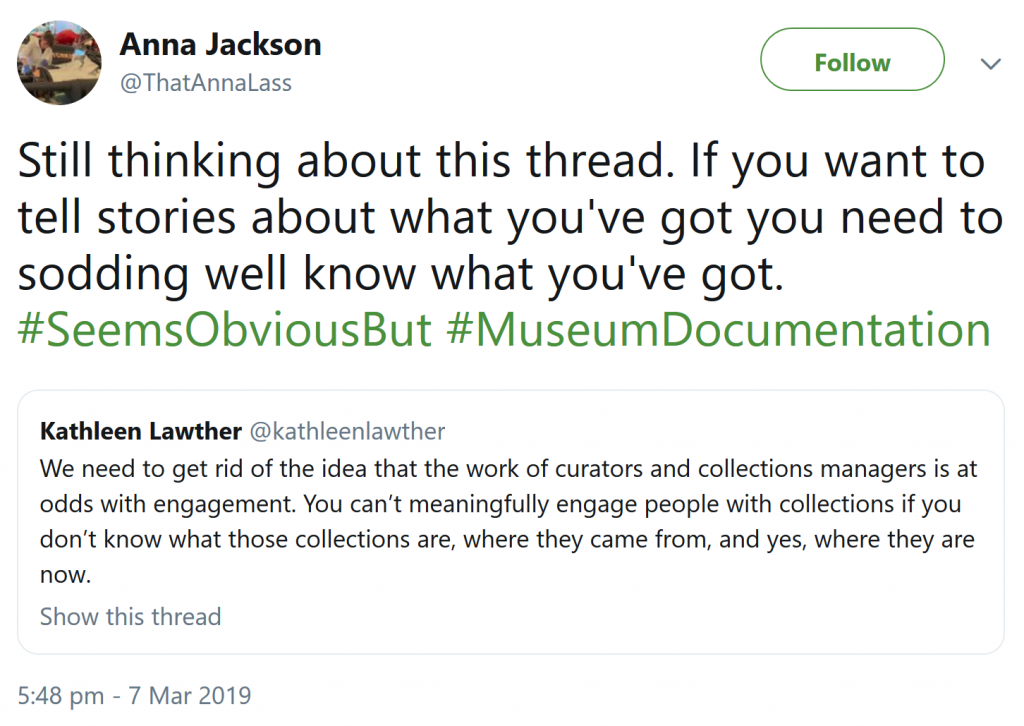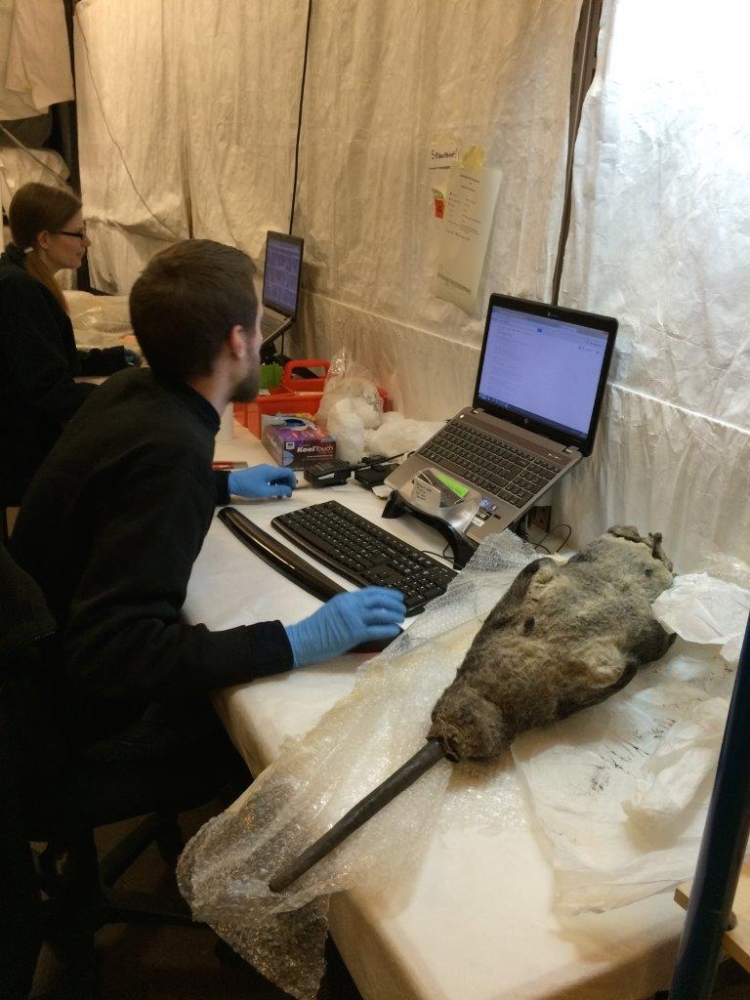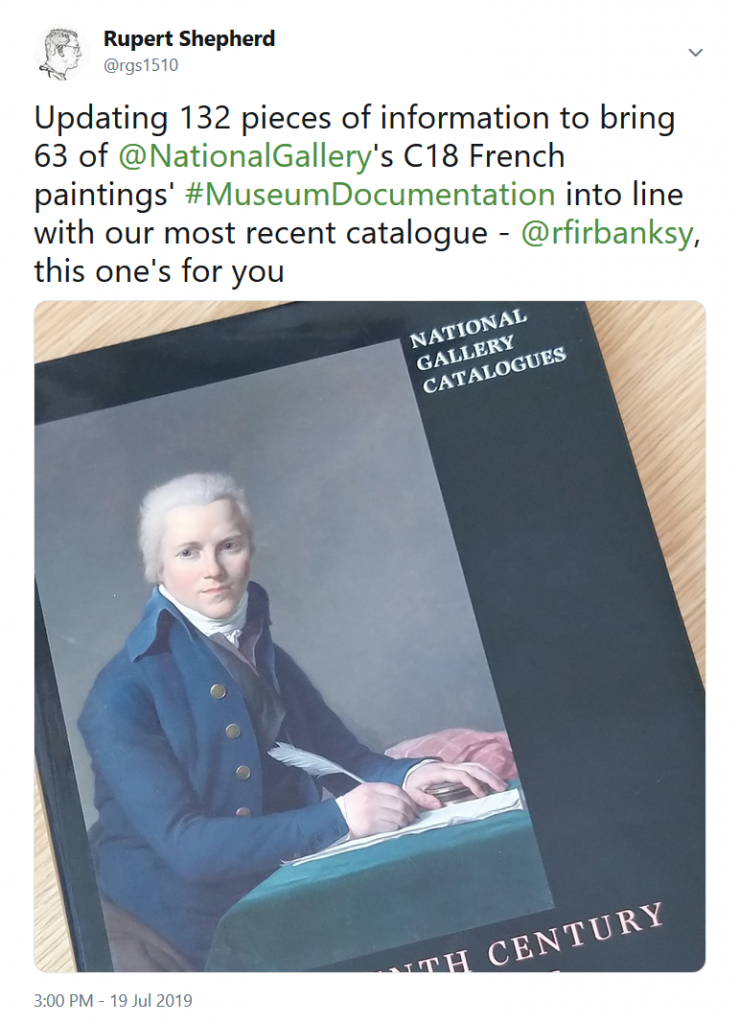A brief paper delivered during a panel discussion on Collections In Flux at Soldiers’ Tales: Collecting and Sharing Military and Musical Heritage, a symposium organised by the Musical Instruments Resource Network and Army Museums Ogilby Trust, at the Faculty of Music, University of Oxford, 22 August 2019.
Collections in flux
Having been asked to speak about documentation with respect to collections in flux, I’d like to begin with a couple of definitions, starting with documentation – for which I’ll use the description provided by CIDOC, the ICOM international committee which deals with documentation:
Museum documentation is concerned with the development and use of information about the objects within a museum collection and the procedures which support the management of the collection.1
In other words, we document collections for three reasons:
- So that we can account for them – can say what objects we own and where they are
- So that we know what the objects actually are
- And, related to this, so that we can use them

As I believe Nick Poole, at one time the head of Collections Trust, once said: ‘documentation is the difference between a museum and a junkshop’.
And ‘flux’? Here I’ll go with the OED, specifically:
flux, n. II. gen. 7. A continuous succession of changes of condition, composition or substance.2
Now it’s precisely when collections are in a state of flux – being moved, assessed, conserved, redisplayed, and so on – that you really, really need to know what you’ve got and where it is; otherwise the risk of objects being lost or damaged (or of people being hurt) is significant. And how many of us here today can, truthfully, say they know exactly how many objects they have in their collections, exactly what each one is, and precisely where it is?
So the first part of any major collection-related project should be to identify what you have: in other words, start by reviewing the part of the collection you will be working on. If your collections are on the move, you’ll probably need to repack them for movement (rather than storage), so I’d strongly recommend that you take advantage of the time when you’ve got the objects out to try and identify them, make sure they’re documented in your system to at least an inventory level of description, and photograph them. Sarah Sinka and I both worked on a major collection review at the Horniman Museum, Collections People Stories, which ran for three years and fed directly into the complete redisplay of their World Gallery, which opened last year. I could say a great deal about what made that project a success – but time is limited, so here’s a link to a presentation I gave about it some time ago (or you could come and talk to Sarah or me over tea).

Once you’ve reviewed your collections, you might be surprised at what you find you have; you’ll certainly find it much easier to plan displays and exhibitions knowing where each object is; and you can also take the opportunity to do things that might help you, like put photographs of objects on their boxes, or barcode your locations, boxes, and objects.
Saying that you need to review your collections may sound like an admission of failure – but it isn’t: it’s a basic activity which every museum should be seriously considering, and is embodied in two new procedures, introduced into the most recent version of Spectrum, the UK Collections Management Standard:
- Documentation planning, a primary procedure, with its focus on the continual improvement of documentation; and
- Collections review.
If you worry that collections management projects like this are unattractive to funders, remind them that you’re doing them to improve public access to, and public engagement with, your collections.
Objects in flux
But collections are made up of objects, and I’d also like to suggest that we think a little about objects in flux – in particular, today, about musical instruments. They are nothing without change: they require movement to make them work, they produce sound by changing the pressure of the air – and their use is frequently accompanied by motion on the part of players, participants and audiences.
I’m sure I don’t need to tell most of you that all this is vital to an understanding of the object, and ideally should be recorded – and this morning, we’ve learnt one way of doing so. But it is not always easy to manage one’s contextual information, as there are few standards for the documentation of intangible cultural heritage and the use of objects. Similarly, there’s not an always an obvious place to record this information in computerised collections management systems – even though Spectrum has for some time included this kind of contextual material amongst the units of information that it expects systems to be able to record, under the headings of
But objects don’t always stop moving once they’ve been acquired, and you should also seriously consider recording how they’re used once they’ve entered the museum. Here, too, Spectrum can help us, with the Use of Collections procedure. But again, it’s not always clear where you might record this kind of information in your collections management system (though I do know that it’s possible in Mimsy, because I drafted the specification for that system’s Use of Collections module).
If you don’t already log similar data, I’d encourage you to do so: first because it records further episodes in your object’s history, and second because it can be very useful when you’re reporting to senior management: it makes it much easier to tell them how busy you’ve been in the stores, the extra resources that you need to service all those visits and events, which objects are getting over-used – and to remind of them that all-important social media post that went viral.
Information in flux
And finally, I’d like to raise the question of information in flux: the way that the very information we record is not static, but mutable. I want to make just a couple of points.
First, opinions change: what we think our object is today is not necessarily the same as what we thought it was fifty years ago. This is something that affects me particularly at the National Gallery, where we continue to reattribute our paintings in the light of our own and other people’s research. Something that’s vexing me at the moment is how to record those changes of opinion – and, crucially, how to record the contexts of those changes: who said it, when, and where was it published? Again, this is not something that all databases make it easy to record at the level of individual units of information (a specific change in date, title, or attribution, say).

Second, there is the broader question of paradigm shifts in how we conceive of our objects and, indeed, our collections. Here, I’m thinking of recent discussions about decolonising museums: a large and complex issue. But I want to close with a recent comment by Mike Jones, an archivist and historian with a strong interest in digital tools and the ethics of museum documentation. In a blog post taking issue with Tristram Hunt’s recent Guardian article about restitution, he says of decolonisation that:
Capturing the resulting complexity requires a more relational approach, connecting various elements to build a complex representation of the context in which things emerge, move, and develop through time.
When it comes to museum documentation this is the real work of decolonisation—not to detach and rarefy, but to embed and reconnect; not to dismantle the history of empire, but to dismantle its privileged perspective; not to de- but to re-contextualise.3
Which brings us back to documenting the contexts of objects and collections in flux.
Notes
- CIDOC, Statement of principles of museum documentation, version 6.2, June 2012, section 1.1, http://network.icom.museum/fileadmin/user_upload/minisites/cidoc/DocStandards/principles6_2.pdf, accessed 5 October 2014. [↩]
- ‘flux, n.’, OED Online (Oxford: Oxford University Press, 2019), https://www.oed.com/view/Entry/72249, accessed 20 August 2019. [↩]
- Mike Jones, Tristram Hunt and the de/recontextualisation of museum artefacts, https://www.mikejonesonline.com/contextjunky/2019/08/08/tristram-hunt-and-the-de-recontextualisation-of-museum-artefacts/, accessed 21 August 2019. [↩]
